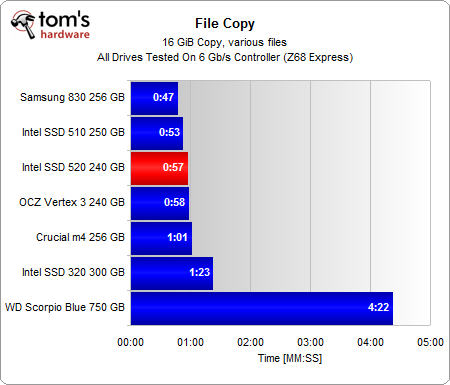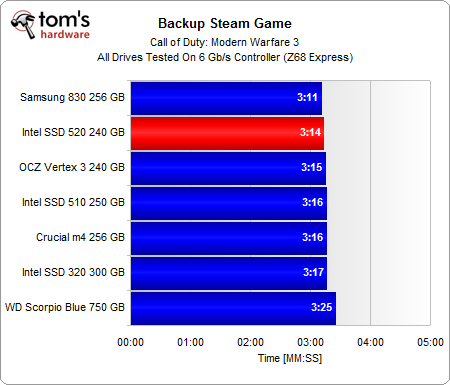Intel SSD 520 Review: Taking Back The High-End With SandForce
Real World Performance: File Copy And Backup
In this particular test, we're transferring 11 GiB worth of H.264-encoded video clips (which, of course, you can't really smash down any more), along with a slew of smaller files that are compressible.
Because this benchmark is dominated by incompressible data, Intel's Marvell-powered SSD 510, totally optimized for sequential transfers, does realy well. It only trails the 256 GB Samsung 830 by a few seconds. The SSD 520 isn't too far behind though, and it manages to match OCZ's Vertex 3.
Just look at the difference between the slowest solid-state drive, Intel's SSD 320, and Western Digital's Scorpio Blue notebook disk, though. This isn't a battle between high-end SSDs at all. It's a matter of ditching mechanical storage in favor of flash-based devices.
Backing up a game using Steam involves a mix of incompressible and compressible sequential writes, along with a sizable number of random write operations. We also observe high CPU utilization, as as individual files are packed into archives. As a result, you don't end up seeing much difference between SATA 3Gb/s- and 6Gb/s-connected drives, or even between the SSDs and hard disk, since storage surprisingly isn't a big bottleneck.
In order to make this test more demanding, we'd need to add concurrent operations. For example, we can move other files to and from the SSD while the backup operation executes with minimal impact. On the hard drive, the same multi-tasked workload slows both actions to a crawl.
Get Tom's Hardware's best news and in-depth reviews, straight to your inbox.
Current page: Real World Performance: File Copy And Backup
Prev Page Steady State Performance (Worst Case) And TRIM Next Page Real-World Performance: Windows And Mac Boot Times-
phamhlam I love Intel SSD. 128GB for about $210 isn't bad. It is just hard to not chose something like a Corsair GT 120GB that cost $150 with rebate over this. I would always put a Intel SSD in a computer for novice since it is reliable.Reply -
jaquith Nice article :)Reply
Just need more SSD's to compare, I'd like to see similar tests done with 120GB...180GB...256GB and several more brands. Further, as I mentioned before in the other article please list the exact model numbers and OEM specs including their 4KB IOPS; otherwise folks don't understand the results and if relying on this a purchasing will have in many cases a 4 in 5 chance of selecting the wrong SSD.
Prior article - http://www.tomshardware.com/reviews/sata-6gbps-performance-sata-3gbps,3110.html -
theuniquegamer costly but i think reliability comes at a price. These ssds are best for enterprises . If the price will be little lower then the common user can afford these and get a good reliable ssd.Reply -
bildo123 "Measuring boot time is one of the best illustrations of how an SSD benefits your computing experience." Be that as it may I find it almost irrelevant seeing as I hardly ever boot my computer, perhaps 2-3 times a month if that. Getting out of standby on my HDD is a matter of seconds.Reply -
danraies These prices are lower than I thought. $20-$40 extra (depending on the comparison) for peace-of-mind is not outrageous.Reply -
acku carn1xHmmm, maybe I missed a good excuse, but I'd like to see the Octane in these tests.Reply
We didn't have the Octane on hand in the 256 GB capacity, but we'll be sure to make that side by side comparison down the road.
phamhlamI love Intel SSD. 128GB for about $210 isn't bad. It is just hard to not chose something like a Corsair GT 120GB that cost $150 with rebate over this. I would always put a Intel SSD in a computer for novice since it is reliable.
Excellent point. Price is always a fickle thing.
thessdreviewNice Review!Thanks Les. :)
jaquithNice article Just need more SSD's to compare, I'd like to see similar tests done with 120GB...180GB...256GB and several more brands. Further, as I mentioned before in the other article please list the exact model numbers and OEM specs including their 4KB IOPS; otherwise folks don't understand the results and if relying on this a purchasing will have in many cases a 4 in 5 chance of selecting the wrong SSD. Prior article - http://www.tomshardware.com/review ,3110.html
We'll keep that mind for future reviews. However, we already list model and firmware on the test page.
Cheers,
Andrew Ku
TomsHardware.com
-
willard bildo123Getting out of standby on my HDD is a matter of seconds.And with an SSD, your computer comes out of standby faster than your monitors do. Not kidding.Reply -
mrkdilkington Anyone else disappointed Intel isn't producing their own high end chipset? Been waiting to upgrade my X25-M for a while now (Intel 320 isn't a big upgrade) but might just go with Samsung.Reply

